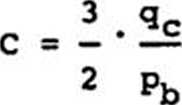6585845001
212
South Africa
TABLE 3
Bearing Capacity Factors
|
degrees |
Vo |
9 |
|
5 |
1,6 |
0,3 |
|
7,5 |
2,0 |
0,6 |
|
10 |
2,5 |
1,0 |
|
12,5 |
3,1 |
1,4 |
|
15 |
4,0 |
1,9 |
|
17,5 |
5,1 |
2,6 |
|
20 |
6,5 |
3,7 |
|
22,5 |
8,5 |
5,3 |
|
25 |
11,0 |
7,3 |
|
27,5 |
14,6 |
10,4 |
|
30 |
19,5 |
15,5 |
|
32,5 |
25,5 |
23,0 |
|
35 |
33,5 |
34,3 |
|
irly all cases, |
however, |
except pos- |
sibly some involving shallow foundations for temporary structures, allowable settlement of the foundation is the controlling factor rather than allowable soil bearing pressure.
Settlement in sand layers has been com-puted from the results of the Dutch cone penetration test using the eguations, given by De Beer and Martens (1957).
medium dense sands. The insitu Buisman-De Beer modulus corresponding to Eąuation (12) is Es = 1,5 qc and the effect of Meyerhofs recommendation as evaluated by Schmertmann (1970) is to change this to Es = 1,9 qc approximately.
In assessing soil compressibility frora the value of qc it is necessary to distin-guish as far as possible between normally Consolidated and overconsolidated soils and to take into account density. Since 1966 such procedures have been employed in South Africa for estimation of settle-ments of structures and reclamation fills in areas underlain by estuarine and allu-vial normally Consolidated sediroents using the following relationships given by Webb (1969) in conjunction with the Boussinesq stress distribution.
Fine to medium sands below ground-water level
E' = - (q + 3200) kN/m2 (13) 2 C
where E* is the reciprocal of my the co-efficient of volume compressibility.
Clayey sands with plasticity index less than 15 percent
Ah 1 pv> + Aov
— = - l°9e - (11)
h C pb


+ 1600) kN/m2
(14)
in which C, the constant of compressibi-lity, is computed from the expression

and where h is the thickness of the layer and is the corresponding increase in effective pressure.
Equation (12) is valid for loose sands in which the stress increment Ao^ is smali in relation to p^, and in which Boussi-nesq's theory or stress distribution is applicable. It is based on Buisman*s work on loose sands for which a volume decrease occurs at the penetrometer cone. In many cases, however, this method has overestimated settlements by ratios of up to 1,5 or morę in fine loose to moderate-ly dense sands with shallow ground-water levels. In medium dense clayey fine sands ratios between calculated and ob-served settlements have approached 2,5. For these reasons it is necessary in prac-tice either to modify Equation (12) by replacing the coefficient *4 by a value a which varies with the soil type as sug-gested by Sanglerat (1972) or to employ semi-empirical relationships between cone resistance and compressibility for diffe-rent soils. Meyerhof (1965) has recom-mended increasing the allowable ground bearing pressure calculated from Equa-tions (11) and (12) by 50 percent in fine
Settlements of structures and fills underlain by normally Consolidated loose to medium dense fine sands and clayey sands calculated from Eguations (13) and (14) have been we 11 within the rangę 2/a to V3 of the observed settlements, the extremes of the rangę being associated with larger settlements in clayey sands which are frequently distributed erratically in the subsoil profiles. Ground bearing pres-sures have generally ranged up to 250 kN/m2.
When significant strata of clay are en-countered the usual procedurę is to base settlement predictions on the results of consolidation tests on specimens cut from 100 mm diameter tubę samples, making allowance, in the laboratory my values, for sample disturbance. Because of the advantages of speed and economy prelimi-nary estimates of settlements in clays are soraetiraes madę from the qc values ob-tained in the Dutch static cone penetrometer tests using Eguation (14). It is found that there is often reasonable agreement between the resulting value of E' and the corresponding laboratory va-lues of my = ł/E* when the field values of qc exceed about 2000 kN/m2, although up to the present time no statistical ana-lysis has been madę of such correlations.
For clays of Iow strength yielding Iow values of q , compressibilities have been determined From the undrained shear
Wyszukiwarka
Podobne podstrony:
296 Sprawozdania i recenzje H. J. Deacon: Notę on the X-ray of two mounted implements from South Afr
BECKLEY (L.E.) 1984 : The ichthyofauna of the Sundays estuary, South Africa, with particular re
1 Physical Sciences NWO-NRF: Cooperation between the Netherlands and South Africa on Astronomy and E
I ntroductionBackground The Netherlands and South Africa have a joint interest in promoting and stre
I ntroductionBackground The Netherlands and South Africa have a joint interest in promoting and stre
62os 6 Lagos, Nigeria. Capc Town, South Africa. Yictoria, Australia. awkłtonc Parli, Englarv
165. Tnc deicgatiom of Bur ma and South Africa arc noc sarisncd that ihc nghts ani interesu of the b
153 USSR The formula (10) was successfully used for the determining of the bearing capacity of piles
Penetration testing in South Africa esoptD.L. Webb State-of-the-
204 South Africa PENETRATION RESISTANCE DESCRIPTION Dark brown ioose fine SAND Dark yellowish brown
205 South Africa BLOWS PER 300mm o
206 South Africa screwed to the end of a string of solid £lush jointed rods approximately 15 mra
207 South Africa The CBR penetrometer is intended for use where access is difficult for
208 South Africa Fj = Total Shaft Friction q c = Cone Resistance Fig. 5. Results of Dutch static con
209 South Africa E* = 358(N + 5) kN/ra2 (5) in saturated clayey fine sands. Ratios
210 South Africa The dynamie cone penetrometer has, how-ever, been used fairly extensively to es-tlm
więcej podobnych podstron